Chen Cao
3DGH: 3D Head Generation with Composable Hair and Face
Jun 25, 2025Abstract:We present 3DGH, an unconditional generative model for 3D human heads with composable hair and face components. Unlike previous work that entangles the modeling of hair and face, we propose to separate them using a novel data representation with template-based 3D Gaussian Splatting, in which deformable hair geometry is introduced to capture the geometric variations across different hairstyles. Based on this data representation, we design a 3D GAN-based architecture with dual generators and employ a cross-attention mechanism to model the inherent correlation between hair and face. The model is trained on synthetic renderings using carefully designed objectives to stabilize training and facilitate hair-face separation. We conduct extensive experiments to validate the design choice of 3DGH, and evaluate it both qualitatively and quantitatively by comparing with several state-of-the-art 3D GAN methods, demonstrating its effectiveness in unconditional full-head image synthesis and composable 3D hairstyle editing. More details will be available on our project page: https://c-he.github.io/projects/3dgh/.
Vid2Avatar-Pro: Authentic Avatar from Videos in the Wild via Universal Prior
Mar 03, 2025Abstract:We present Vid2Avatar-Pro, a method to create photorealistic and animatable 3D human avatars from monocular in-the-wild videos. Building a high-quality avatar that supports animation with diverse poses from a monocular video is challenging because the observation of pose diversity and view points is inherently limited. The lack of pose variations typically leads to poor generalization to novel poses, and avatars can easily overfit to limited input view points, producing artifacts and distortions from other views. In this work, we address these limitations by leveraging a universal prior model (UPM) learned from a large corpus of multi-view clothed human performance capture data. We build our representation on top of expressive 3D Gaussians with canonical front and back maps shared across identities. Once the UPM is learned to accurately reproduce the large-scale multi-view human images, we fine-tune the model with an in-the-wild video via inverse rendering to obtain a personalized photorealistic human avatar that can be faithfully animated to novel human motions and rendered from novel views. The experiments show that our approach based on the learned universal prior sets a new state-of-the-art in monocular avatar reconstruction by substantially outperforming existing approaches relying only on heuristic regularization or a shape prior of minimally clothed bodies (e.g., SMPL) on publicly available datasets.
LUCAS: Layered Universal Codec Avatars
Feb 27, 2025



Abstract:Photorealistic 3D head avatar reconstruction faces critical challenges in modeling dynamic face-hair interactions and achieving cross-identity generalization, particularly during expressions and head movements. We present LUCAS, a novel Universal Prior Model (UPM) for codec avatar modeling that disentangles face and hair through a layered representation. Unlike previous UPMs that treat hair as an integral part of the head, our approach separates the modeling of the hairless head and hair into distinct branches. LUCAS is the first to introduce a mesh-based UPM, facilitating real-time rendering on devices. Our layered representation also improves the anchor geometry for precise and visually appealing Gaussian renderings. Experimental results indicate that LUCAS outperforms existing single-mesh and Gaussian-based avatar models in both quantitative and qualitative assessments, including evaluations on held-out subjects in zero-shot driving scenarios. LUCAS demonstrates superior dynamic performance in managing head pose changes, expression transfer, and hairstyle variations, thereby advancing the state-of-the-art in 3D head avatar reconstruction.
URAvatar: Universal Relightable Gaussian Codec Avatars
Oct 31, 2024

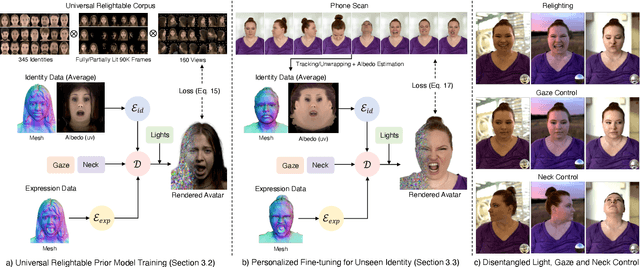
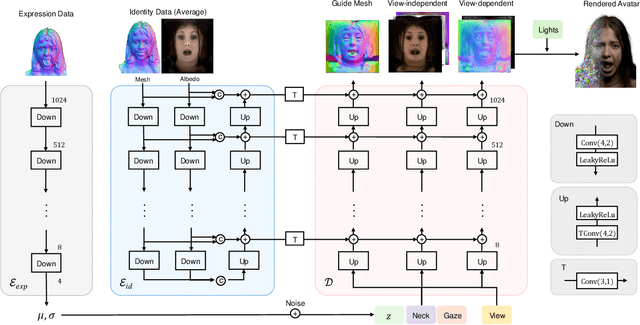
Abstract:We present a new approach to creating photorealistic and relightable head avatars from a phone scan with unknown illumination. The reconstructed avatars can be animated and relit in real time with the global illumination of diverse environments. Unlike existing approaches that estimate parametric reflectance parameters via inverse rendering, our approach directly models learnable radiance transfer that incorporates global light transport in an efficient manner for real-time rendering. However, learning such a complex light transport that can generalize across identities is non-trivial. A phone scan in a single environment lacks sufficient information to infer how the head would appear in general environments. To address this, we build a universal relightable avatar model represented by 3D Gaussians. We train on hundreds of high-quality multi-view human scans with controllable point lights. High-resolution geometric guidance further enhances the reconstruction accuracy and generalization. Once trained, we finetune the pretrained model on a phone scan using inverse rendering to obtain a personalized relightable avatar. Our experiments establish the efficacy of our design, outperforming existing approaches while retaining real-time rendering capability.
A Systematic Review on Prompt Engineering in Large Language Models for K-12 STEM Education
Oct 14, 2024

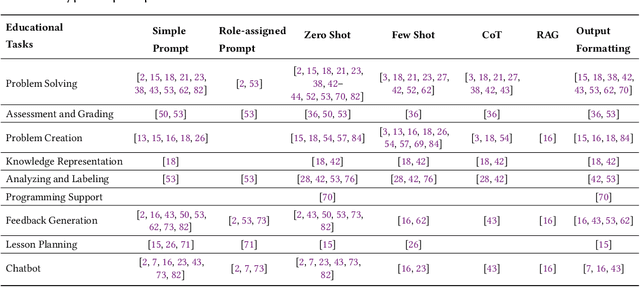
Abstract:Large language models (LLMs) have the potential to enhance K-12 STEM education by improving both teaching and learning processes. While previous studies have shown promising results, there is still a lack of comprehensive understanding regarding how LLMs are effectively applied, specifically through prompt engineering-the process of designing prompts to generate desired outputs. To address this gap, our study investigates empirical research published between 2021 and 2024 that explores the use of LLMs combined with prompt engineering in K-12 STEM education. Following the PRISMA protocol, we screened 2,654 papers and selected 30 studies for analysis. Our review identifies the prompting strategies employed, the types of LLMs used, methods of evaluating effectiveness, and limitations in prior work. Results indicate that while simple and zero-shot prompting are commonly used, more advanced techniques like few-shot and chain-of-thought prompting have demonstrated positive outcomes for various educational tasks. GPT-series models are predominantly used, but smaller and fine-tuned models (e.g., Blender 7B) paired with effective prompt engineering outperform prompting larger models (e.g., GPT-3) in specific contexts. Evaluation methods vary significantly, with limited empirical validation in real-world settings.
Bridging the Gap: Studio-like Avatar Creation from a Monocular Phone Capture
Jul 28, 2024Abstract:Creating photorealistic avatars for individuals traditionally involves extensive capture sessions with complex and expensive studio devices like the LightStage system. While recent strides in neural representations have enabled the generation of photorealistic and animatable 3D avatars from quick phone scans, they have the capture-time lighting baked-in, lack facial details and have missing regions in areas such as the back of the ears. Thus, they lag in quality compared to studio-captured avatars. In this paper, we propose a method that bridges this gap by generating studio-like illuminated texture maps from short, monocular phone captures. We do this by parameterizing the phone texture maps using the $W^+$ space of a StyleGAN2, enabling near-perfect reconstruction. Then, we finetune a StyleGAN2 by sampling in the $W^+$ parameterized space using a very small set of studio-captured textures as an adversarial training signal. To further enhance the realism and accuracy of facial details, we super-resolve the output of the StyleGAN2 using carefully designed diffusion model that is guided by image gradients of the phone-captured texture map. Once trained, our method excels at producing studio-like facial texture maps from casual monocular smartphone videos. Demonstrating its capabilities, we showcase the generation of photorealistic, uniformly lit, complete avatars from monocular phone captures. \href{http://shahrukhathar.github.io/2024/07/22/Bridging.html}{The project page can be found here.}
Universal Facial Encoding of Codec Avatars from VR Headsets
Jul 17, 2024



Abstract:Faithful real-time facial animation is essential for avatar-mediated telepresence in Virtual Reality (VR). To emulate authentic communication, avatar animation needs to be efficient and accurate: able to capture both extreme and subtle expressions within a few milliseconds to sustain the rhythm of natural conversations. The oblique and incomplete views of the face, variability in the donning of headsets, and illumination variation due to the environment are some of the unique challenges in generalization to unseen faces. In this paper, we present a method that can animate a photorealistic avatar in realtime from head-mounted cameras (HMCs) on a consumer VR headset. We present a self-supervised learning approach, based on a cross-view reconstruction objective, that enables generalization to unseen users. We present a lightweight expression calibration mechanism that increases accuracy with minimal additional cost to run-time efficiency. We present an improved parameterization for precise ground-truth generation that provides robustness to environmental variation. The resulting system produces accurate facial animation for unseen users wearing VR headsets in realtime. We compare our approach to prior face-encoding methods demonstrating significant improvements in both quantitative metrics and qualitative results.
* SIGGRAPH 2024 (ACM Transactions on Graphics (TOG))
URHand: Universal Relightable Hands
Jan 10, 2024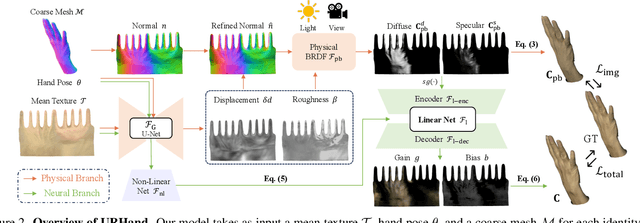
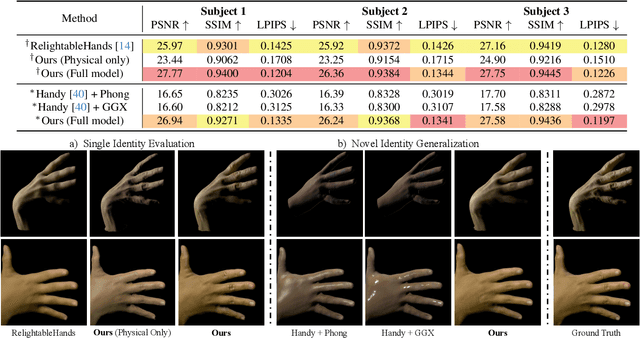

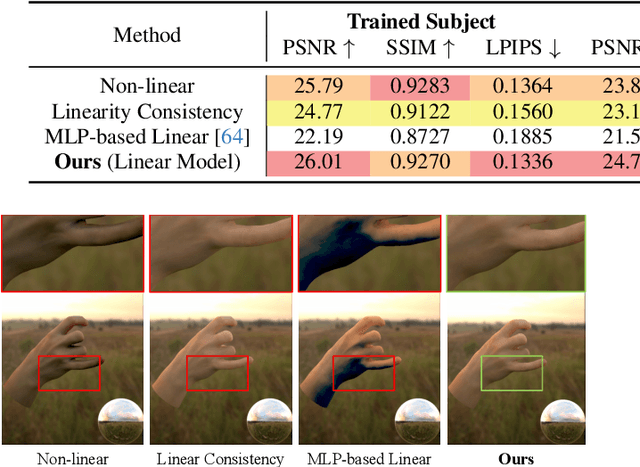
Abstract:Existing photorealistic relightable hand models require extensive identity-specific observations in different views, poses, and illuminations, and face challenges in generalizing to natural illuminations and novel identities. To bridge this gap, we present URHand, the first universal relightable hand model that generalizes across viewpoints, poses, illuminations, and identities. Our model allows few-shot personalization using images captured with a mobile phone, and is ready to be photorealistically rendered under novel illuminations. To simplify the personalization process while retaining photorealism, we build a powerful universal relightable prior based on neural relighting from multi-view images of hands captured in a light stage with hundreds of identities. The key challenge is scaling the cross-identity training while maintaining personalized fidelity and sharp details without compromising generalization under natural illuminations. To this end, we propose a spatially varying linear lighting model as the neural renderer that takes physics-inspired shading as input feature. By removing non-linear activations and bias, our specifically designed lighting model explicitly keeps the linearity of light transport. This enables single-stage training from light-stage data while generalizing to real-time rendering under arbitrary continuous illuminations across diverse identities. In addition, we introduce the joint learning of a physically based model and our neural relighting model, which further improves fidelity and generalization. Extensive experiments show that our approach achieves superior performance over existing methods in terms of both quality and generalizability. We also demonstrate quick personalization of URHand from a short phone scan of an unseen identity.
A Local Appearance Model for Volumetric Capture of Diverse Hairstyle
Dec 14, 2023



Abstract:Hair plays a significant role in personal identity and appearance, making it an essential component of high-quality, photorealistic avatars. Existing approaches either focus on modeling the facial region only or rely on personalized models, limiting their generalizability and scalability. In this paper, we present a novel method for creating high-fidelity avatars with diverse hairstyles. Our method leverages the local similarity across different hairstyles and learns a universal hair appearance prior from multi-view captures of hundreds of people. This prior model takes 3D-aligned features as input and generates dense radiance fields conditioned on a sparse point cloud with color. As our model splits different hairstyles into local primitives and builds prior at that level, it is capable of handling various hair topologies. Through experiments, we demonstrate that our model captures a diverse range of hairstyles and generalizes well to challenging new hairstyles. Empirical results show that our method improves the state-of-the-art approaches in capturing and generating photorealistic, personalized avatars with complete hair.
Elucidating STEM Concepts through Generative AI: A Multi-modal Exploration of Analogical Reasoning
Aug 21, 2023

Abstract:This study explores the integration of generative artificial intelligence (AI), specifically large language models, with multi-modal analogical reasoning as an innovative approach to enhance science, technology, engineering, and mathematics (STEM) education. We have developed a novel system that utilizes the capacities of generative AI to transform intricate principles in mathematics, physics, and programming into comprehensible metaphors. To further augment the educational experience, these metaphors are subsequently converted into visual form. Our study aims to enhance the learners' understanding of STEM concepts and their learning engagement by using the visual metaphors. We examine the efficacy of our system via a randomized A/B/C test, assessing learning gains and motivation shifts among the learners. Our study demonstrates the potential of applying large language models to educational practice on STEM subjects. The results will shed light on the design of educational system in terms of harnessing AI's potential to empower educational stakeholders.
 Add to Chrome
Add to Chrome Add to Firefox
Add to Firefox Add to Edge
Add to Edge